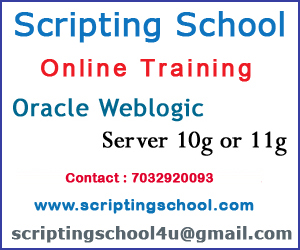1. Introduction
15. Add-Ones
- Introduction to Java and J2EE
- Overview on JVM
- Introduction to J2EE Architecture
- Installations of WebLogic Server 10G/11G
- Domains, Administration Servers and Managed Servers
- Administration Console
- Management Beans and Java Management Extension (JMX)
- Setting up WebLogic Server as Service
- Starting and Stopping WebLogic Administration Server
- Adding a WebLogic Managed Server to a Domain
- Starting and Stopping a WebLogic Managed Server
- Registering Startup and Shutdown Classes
- Introduction to WLST
- Invoking WLST
- Change Management Process
- Configuring domains using WLST
- WLST scripts
- What is recording feature
- How to create the server using the WLST
- Deployment using the WLST
- Taking the thread dump through the WLST
- Introduction to NodeManager
- Node Architecture
- Configuring NodeManager
- NodeManager properties files
- Starting/stopping Node Manager
- Dynamic Deployment
- Deployment of Enterprise JavaBeans
- Configuration and Deployment of Web Applications
- Using Administration Console to Deploy Applications
- Use WebLogic Server as a Web Server
- Virtual Hosting
- Configuring a Web Server to Work with WebLogic Server
- Side-by-side deployment
- Deployment Plans
- What is trust
- Basic Concepts of public key, private key and certification authentication.
- Basic Concepts of Authorization and Authentication
- Defining Users, Groups, and Role’s
- Configuring Security in Web Applications
- Security Fame work
- How to unlock the user
- How to create the read only user
- JDBC Overview
- Setting up and Manage JDBC Connection Pools
- Setting up and Manage JDBC DataSources
- Create and Manage MultiPools
- JMS Overview
- Configuring Connection Factories
- Configuring JMS Servers
- Configuring JMS Module
- Configuring Connection Consumers
- Monitoring JMS
- Introduction to WebLogic Server Clustering
- Create a New Cluster
- Configure Replication Groups
- How the cluster members are commutates each others
- Starting a WebLogic Server Cluster
- Load Balancing of Clustered Services
- Failover Support for Clustered Services
- Cluster-Wide JNDI Naming Service
- HTTP Session State Replication
- Firewall Considerations for Clusters
- What is hear beat
- Installing Apache HTTP Server
- Integrating Apache with Weblogic server.
- Starting/Stopping Apache
- Integrating WLS with Apache Servers using (Plug-ins)
- What is virtual hosting
- Types of virtual hosting
- Configuration of virtual hosting
- Overview of Monitoring
- Monitoring Servers
- Overview of Logging Subsystem
- Log File Format
- Message Attributes
- Viewing the Logs
- Overview of Monitoring
15. Add-Ones
- RealTime Architectures
- RealTime Tool
- Non Technical issues.
- Sample RealTime Architectures
- Daily Activities of the WebLogic Administrators
- Common Errors during WebLogic Administration

